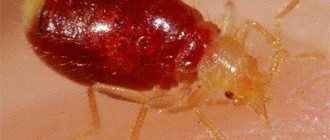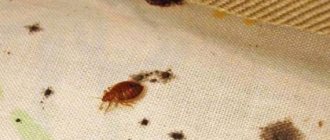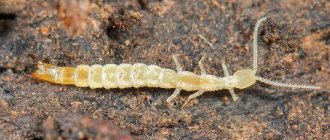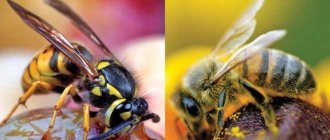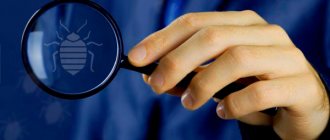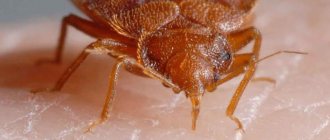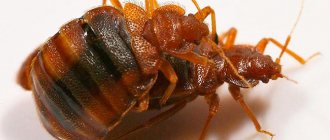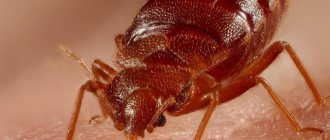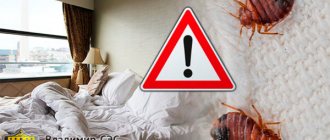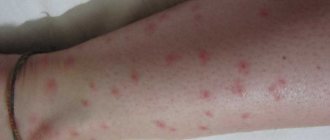A long time ago, the inhabitants of stone caves experienced the torment of being close to bedbugs. A lot of time has passed since then, but the problem remains relevant. Modern apartments with European-quality renovation, luxurious mansions and expensive houses outside the bustle of the city - they are all susceptible to the invasion of these intrusive insects. It goes without saying that this situation leads to increased interest among relatively small vampires. But what do you personally know about bedbugs? Are you aware of the intricacies of their life and nutrition processes? If not, then sit back and go with us to get acquainted with the main enemy of modern man - the bedbug.
What do bed bugs eat?
House bugs feed only on the blood of mammals, mainly human. This is the easiest object to access, since the skin of animals is dense and difficult to bite through. Therefore, parasites move into apartments and houses, closer to the source of food.
Bloodsuckers are nocturnal, going out to hunt when a person is fast asleep, and are unable to resist. Adult parasites come out to feed once every 7-10 days, and the larvae attach themselves to the victim every day. Their peak activity occurs between 3 and 6 am.
Since, when biting, an adult injects an anesthetic substance, the bite itself is not immediately felt. Nymphs do not have this feature, which is why their attacks are more painful and are felt instantly.
After such raids, traces remain on a person’s body: red dots that subsequently begin to itch very much. Attacks are possible on everyone living in the house, even animals. Sometimes, one person becomes the object of desire for bloodsuckers. Elderly people are less at risk of being bitten by bedbugs than children and young women. The latter have softer skin, which is why they are so attractive to bloodsuckers.
Bed bugs and their diet in nature
Insects and their larvae cause a lot of trouble to humans. They belong to the order Hemiptera, which unites 40 thousand different species. The feeding methods of pests are different. In addition to blood, which serves as their main food, many parasites can assimilate plant juices and animal hemolymph. Unlike other insects that are herbivores or predators, bed bugs only consume blood.
They can live in a person’s apartment, in a cave with a flock of bats, or in a village chicken coop. Everywhere these pests find food for themselves - the blood of the inhabitants.
Parasites easily penetrate hairless areas of the victim's body while she sleeps.
The saliva of insects and their larvae contains an enzyme that stops coagulation (blood clotting). As soon as the substance enters the human blood, the protective mechanism that prevents its loss fails. Therefore, adults and larvae are able to absorb blood in the volume necessary for complete saturation.
Bedbug saturation stages.
Features of bedbugs
Bedbugs are sucking insects belonging to the order Hemiptera. They are endowed with a piercing-sucking oral apparatus, adapted for the consumption of liquid food. Consists of a lower lip transformed into a pointed hollow tube. The parasite pierces the surface layer of the epidermis or plant.
During the period of inactivity of insects, the proboscis is pressed against the bottom of the head or chest. So, domestic bugs have a special recess on the peritoneum where it is placed. Before starting a meal, the bug selects a convenient area for a puncture, puts out its proboscis and begins to intensively rotate its head.
As a result of such manipulations, a sharp tip protrudes from the proboscis, like a needle. They puncture the skin, where the trunk is instantly inserted. The nutritional organ includes 2 parallel tubules: one for the introduction of an anesthetic enzyme, the second for the absorption of food. At one time, the insect absorbs up to one and a half milligrams of nutrient.
Having fully eaten, the insect swells up like a balloon. Becomes dark red in color. In this state, it becomes less agile, and therefore more vulnerable. That is why red spots are found on the bed, formed when a person crushes well-fed parasites while turning over in his sleep.
Bedbug bites differ from others in that they are arranged in a strict sequence - in the form of a chain. This is due to the fact that the parasite does not have time to get enough in one go, crawls away and gives another injection. There can be up to 20-25 such attempts.
Parasites choose open areas of the body and those in contact with the bed; they do not crawl under clothes. They also do not function in the hairline, so these areas are safe.
How long can bed parasites survive without food?
People are not always at home. Sometimes they travel, go on business trips, visit friends with an overnight stay. Then the parasites are deprived of food. It is important to find out how long a bed bug lives without food.
This will help you understand whether you should expect their death during the owner’s absence.
Due to lack of food, bedbugs begin to attack people
Anabiosis as a means of survival without food
This period is called diapause. At this stage, the parasites’ body forcibly inhibits metabolism, which reduces the need for food. For many pests, this period is mandatory and is associated with a decrease in daylight hours. However, optional diapause is also noted.
In this case, the parasite enters a phase similar to suspended animation, involuntarily, when it finds itself in unsuitable conditions, and is also deprived of a food source.
How long do bedbugs live without human blood?
The duration of the diapause period can be 1 year. Without human blood, insects remain until another food source is nearby: an animal, birds. However, indoors at home, the likelihood of this happening is low. The parasites enter the diapause phase in the second week of the hunger strike. At the same time, their body dries out and becomes even flatter. It can be assumed that the pests have died.
Without food, they remain in this state for a long time, but only until a person appears nearby.
If a bug starves for a long time, the body becomes flat
Adult bed bug
How long can bedbugs live in an empty apartment?
When people leave, the parasites look for a way to survive. They are waiting for a warm-blooded creature to appear. However, no one will be able to enter a closed apartment without people. This means that insects have no choice but to maintain viability at a minimum level to save resources. If the premises are residential, then the person will return sooner or later, and after a short period of time. Typically, the period of starvation of the bedbug population does not drag on in this case - it lasts 1-3 weeks.
But pests are able to remain without food much longer in an empty apartment.
What do bedbugs eat when there are no people
If the main source of feeding bedbugs is people who are absent from the apartment for a long time, then the bedbugs act as follows:
- Switch to pets. They don't particularly like cats and dogs, as they have thick fur. This prevents their free movement. But in the absence of other food, one has to be content with this.
- Birds can become victims; chickens are especially susceptible to parasitic attacks. They have exposed skin, which is perfect for parasites.
- They can drink the blood of domestic rodents: mice, rats, hamsters.
- In the complete absence of a potential warm-blooded object, the parasites migrate to neighboring living quarters.
Bedbugs tend to go without food for a long time, without harm to metabolism and reproduction. They can easily fast for up to 2 months, so long journeys from one territory to another do not cause them discomfort.
When the temperature drops to 15 °C, in the absence of blood nearby, the blood-sucking pests go into hibernation, in which they can remain for a year or more. With the return of warmth and people, the parasites come to life and continue to function no less actively. When the temperature rises above 50 degrees, they die.
Traditional methods in the fight against bedbugs
For those who ask the question: how to get rid of bedbugs in an apartment, the SES recommends not delaying contacting exterminators. But here, too, competition in the form of dozens of tips posted on different websites and in print publications has a negative impact. For example, if it is possible to completely renovate, you can simply use paint and other finishing materials with a strong odor to expel and destroy bedbugs. Bed or upholstered furniture can be treated with turpentine or wormwood solution, then packed in plastic. It is better to choose a packaging one and seal it with tape. In this way, it is possible to neutralize the threat in a short time. You can also treat suspicious areas with a steam generator.
Why are bloodsuckers dangerous?
Despite the fact that bloodsuckers do not carry infectious diseases, their bites cause a lot of discomfort. If they are not felt during night attacks, then the next morning inflammation and unbearable itching appear. Allergy sufferers may have more serious consequences: urticaria, Quincke's edema and even anaphylactic shock.
From such attacks a person does not get enough sleep, becomes nervous and irritable. Against this background, chronic diseases worsen. Children are more likely to scratch bite marks, which causes pathogenic bacteria to penetrate inside.
The daily damage depends on the number of parasites - the more there are, the more aggressive they become, since not everyone has enough food. If they are detected, it is recommended to take immediate extermination measures to prevent the population from growing.
The presence of parasitic settlements in an apartment can be determined by several signs:
- red stains on pajamas and bed linen;
- black debris on the sheet is parasite excrement;
- dark husk - scales shed during molting;
- unpleasant nauseating odor.
The last option is possible when there are too many parasites in the room.
Since they reproduce intensively, even one individual accidentally brought into the house is capable of creating a large colony in a month. Parasites enter residential premises in different ways:
- from neighbors, through through holes;
- on the external walls of high-rise buildings;
- by skidding on old furniture and things;
- with luggage, after a long vacation or business trips.
For a comfortable existence, they require warmth and the presence of a nearby power source.
How to deal with the problem quickly?
Having discovered bedbug habitats in an apartment, how to get rid of the entire population of parasites? First of all, it is worth assessing the intensity of the infection. For example, if insects have appeared recently, treatment can be carried out without wasting time using aerosols. They treat the discovered nests. If the infection is of moderate severity, a specific smell is felt, and empty egg shells can be found in the house, you should think about using formulations sold in concentrated form. They are just as effective, but provide a more prolonged effect against pests and help prevent re-infestation of the home by a new generation of bedbugs hatched from eggs laid by females.
How long can bedbugs live without bleeding?
How long can a bug live without blood? Long enough. If you leave your apartment for a couple of months on vacation, it will be almost invisible to bedbugs. If food rations are reduced, bedbugs simply slow down their vital activity, practically falling into a state of suspended animation. Outwardly, it may seem that the bug is dead, because in some cases they even lie belly up when they fall into suspended animation. But as soon as they smell blood, these insects immediately become more active and continue their life activities as if nothing had happened. Interestingly, a bug can live in this state of suspended animation for more than a year, which practically eliminates the possibility of bedbugs leaving their homes on their own, since living quarters are rarely left empty for such a long period of time.
Stages of development from egg to adult bedbug
There are several main stages:
- the emergence of a larva from an egg - body length is 1 mm, and the color of the outer integument is milky;
- nymph – the size of the parasite is 1.5-4 mm, the color is darker (from light brown to a more saturated shade);
- imago - body length 5-8 mm, color of outer integument - brown.
The larval cycle includes 5 molting stages. This is a natural process of changing the appearance and acquiring new functions of the body. At each stage the nymph grows. The developmental leap provides the possibility of an increase of 0.5 mm (average).
Stages of bedbug development from egg to adult Bedbugs at different stages of development
What blood type do they like?
Many people are interested in knowing which blood type bedbugs prefer. There is an opinion that parasites do not spare some people at all, while others may not be touched at all.
Bed bugs prefer to bite some people not based on what blood type they have, but based on the thickness of the skin, hair growth and other factors.
Bloodsuckers are not physiologically capable of determining other blood parameters. That is, insects bite equally in representatives of all groups, regardless of the Rh factor.
People have different body sensitivity to the bites of bloodsuckers, and not everyone can understand in the morning that they were attacked by a clan of bedbugs. When consuming blood, bedbugs drink it more often from women and children.
This is due to the thinness of the skin and the minimum amount of hair on the body. At the same time, parasites are attracted to the exhaled smell of carbon dioxide, which is more abundant in a massive man. Therefore, everyone is susceptible to bites without restrictions on age, gender or blood type.
